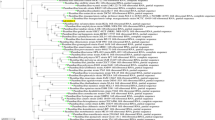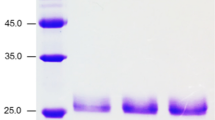Abstract
Two new endo-1,4-beta-xylanases encoding genes EpXyn1 and EpXyn3 were isolated from mesophilic fungus Eupenicillium parvum 4–14. Based on analysis of catalytic domain and phylogenetic trees, the xylanases EpXYN1 (404 aa) and EpXYN3 (220 aa) belong to glycoside hydrolase (GH) family 10 and 11, respectively. Both EpXYN1 and EpXYN3 were successfully expressed in Pichia pastoris and the recombinant enzymes were characterized using beechwood xylan, birchwood xylan, or oat spelt xylan as substrates, respectively. The optimum temperatures and pH values were 75 °C and 5.5 for EpXYN1, and 55 °C and 5.0 for EpXYN3. EpXYN1 exhibited a high stability at high temperature (65 °C) or at pH values from 8 to 10. EpXYN3 kept over 80% enzymatic activity after treatment at pH values from 3 to 10. The specific activities of EpXYN1 and EpXYN3 were 384.42 and 214.20 U/mg using beechwood xylan as substrate, respectively. EpXYN1 showed lower Km values and higher specific activities toward different xylans compared to EpXYN3. Thin-layer chromatography analysis indicated that the hydrolysis profiles of xylans or xylo-oligosacharides were different by EpXYN1and EpXYN3. EpXYN3 had a higher efficiency than EpXYN1 in production of feruloylated oligosaccharides (FOs) from de-starched wheat bran. The maximum levels of FOs released by EpXYN1 and EpXYN3 were 11.1 and 14.4 μmol/g, respectively. In conclusion, the two xylanases are potential candidates for various industrial applications.







Similar content being viewed by others
References
Peng, F., Peng, P., Xu, F., & Sun, R. C. (2012). Fractional purification and bioconversion of hemicelluloses. Biotechnology Advances, 30(4), 879–903.
Liu, J., Chinga-Carrasco, G., Cheng, F., Xu, W., Willför, S., Syverud, K., & Xu, C. (2016). Hemicellulose-reinforced nanocellulose hydrogels for wound healing application. Cellulose, 23(5), 3129–3143.
Li, H., Wu, H., Jiang, F., Wu, J., Xue, Y., Gan, L., Liu, J., & Long, M. (2018). Heterologous expression and characterization of an acidic GH11 family xylanase from Hypocrea orientalis. Applied Biochemistry and Biotechnology, 184, 228–238.
Zhou, X., Li, W., Mabon, R., & Broadbelt, L. J. (2017). A critical review on hemicellulose pyrolysis. Energy Technology, 5(1), 52–79.
Collins, T., Gerday, C., & Feller, G. (2005). Xylanases, xylanase families and extremophilic xylanases. FEMS Microbiology Reviews, 29(1), 3–23.
Chakdar, H., Kumar, M., Pandiyan, K., Singh, A., Nanjappan, K., Kashyap, P. L., & Srivastava, A. K. (2016). Bacterial xylanases: Biology to biotechnology. 3 Biotech, 6(2), 150.
Liao, H., Zheng, H., Li, S., Wei, Z., Mei, X., Ma, H., Shen, Q., & Xu, Y. (2015). Functional diversity and properties of multiple xylanases from Penicillium oxalicum GZ-2. Scientific Reports, 5,12631.
Juodeikiene, G., Basinskiene, L., Vidmantiene, D., Makaravicius, T., & Bartkiene, E. (2012). Benefits of β-xylanase for wheat biomass conversion to bioethanol. Journal of the Science of Food and Agriculture, 92(1), 84–91.
Murugesan, G. R., & Persia, M. E. (2015). Influence of a direct-fed microbial and xylanase enzyme on the dietary energy uptake efficiency and performance of broiler chickens. Journal of the Science of Food and Agriculture, 95(12), 2521–2527.
Juturu, V., & Wu, J. C. (2012). Microbial xylanases: Engineering, production and industrial applications. Biotechnology Advances, 30(6), 1219–1227.
Chutani, P., & Sharma, K. K. (2015). Biochemical evaluation of xylanases from various filamentous fungi and their application for the deinking of ozone treated newspaper pulp. Carbohydrate Polymers, 127, 54–63.
Zhang, H.-M., Wang, J.-Q., Wu, M.-C., Gao, S.-J., Li, J.-F., & Yang, Y.-J. (2014). Optimized expression, purification and characterization of a family 11 xylanase (AuXyn11A) from Aspergillus usamii E001 in Pichia pastoris. Journal of the Science of Food and Agriculture, 94(4), 699–706.
Morgan, N. K., Wallace, A., Bedford, M. R., & Choct, M. A. (2017). Efficiency of xylanases from families 10 and 11 in production of xylo-oligosaccharides from wheat arabinoxylans. Carbohydrate Polymers, 167, 290–296.
Miao, Y., Li, P., Li, G., Liu, D., Druzhinina, I. S., Kubicek, C. P., Shen, Q., & Zhang, R. (2017). Two degradation strategies for overcoming the recalcitrance of natural lignocellulosic xylan by polysaccharides-binding GH10 and GH11 xylanases of filamentous fungi. Environmental Microbiology, 19(3), 1054–1064.
Meng, D.-D., Ying, Y., Chen, X.-H., Lu, M., Ning, K., Wang, L.-S., & Li, F.-L. (2015). Distinct roles for carbohydrate-binding modules of glycoside hydrolase 10 (GH10) and GH11 xylanases from Caldicellulosiruptor sp. strain F32 in thermostability and catalytic efficiency. Applied and Environmental Microbiology, 81(6), 2006–2014.
Tang, F., Chen, D., Yu, B., Luo, Y., Zheng, P., Mao, X., Yu, J., & He, J. (2017). Improving the thermostability of Trichoderma reesei xylanase 2 by introducing disulfide bonds. Electronic Journal of Biotechnology, 26, 52–59.
Kumar, V., Marín-Navarro, J., & Shukla, P. (2016). Thermostable microbial xylanases for pulp and paper industries: Trends, applications and further perspectives. World Journal of Microbiology and Biotechnology, 32(2), 34.
Du, Y., Shi, P., Huang, H., Zhang, X., Luo, H., Wang, Y. R., & Yao, B. (2013). Characterization of three novel thermophilic xylanases from Humicola insolens Y1 with application potentials in the brewing industry. Bioresource Technology, 130, 161–167.
Silva, S. B., Pinheiro, M. P., Fuzo, C. A., Silva, S. R., Ferreira, T. L., Lourenzoni, M. R., Nonato, M. C., Vieira, D. S., & Ward, R. J. (2017). The role of local residue environmental changes in thermostable mutants of the GH11 xylanase from Bacillus subtilis. International Journal of Biological Macromolecules, 97, 574–584.
Gopalan, N., Rodriguez-Duran, L. V., Saucedo-Castaneda, G., & Nampoothiri, K. M. (2015). Review on technological and scientific aspects of feruloyl esterases: A versatile enzyme for biorefining of biomass. Bioresource Technology, 193, 534–544.
Kumar, N., & Pruthi, V. (2014). Potential applications of ferulic acid from natural sources. Biotechnology Reports, 4, 86–93.
Uraji, M., Arima, J., Inoue, Y., Harazono, K., & Hatanaka, T. (2014). Application of two newly identified and characterized feruloyl esterases from Streptomyces sp. in the enzymatic production of ferulic acid from agricultural biomass. PLoS One, 9(8), e104584.
Lapierre, C., Pollet, B., Ralet, M.-C., & Saulnier, L. (2001). The phenolic fraction of maize bran: Evidence for lignin-heteroxylan association. Phytochemistry, 57(5), 765–772.
Ou, J., & Sun, Z. (2014). Feruloylated oligosaccharides: Structure, metabolism and function. Journal of Functional Foods, 7, 90–100.
Xie, C., Wu, Z., Guo, H., & Gu, Z. (2014). Release of feruloylated oligosaccharides from wheat bran through submerged fermentation by edible mushrooms. Journal of Basic Microbiology, 54(S1), S14–S20.
Katapodis, P., & Christakopoulos, P. (2008). Enzymic production of feruloyl xylo-oligosaccharides from corn cobs by a family 10 xylanase from Thermoascus aurantiacus. Lwt-Food Science and Technology, 41(7), 1239–1243.
Long, L., Ding, D., Han, Z., Zhao, H., Lin, Q., & Ding, S. (2016). Thermotolerant hemicellulolytic and cellulolytic enzymes from Eupenicillium parvum 4-14 display high efficiency upon release of ferulic acid from wheat bran. Journal of Applied Microbiology, 121(2), 422–434.
Zheng, F., Huang, J., Liu, X., Hu, H., Long, L., Chen, K., & Ding, S. (2016). N- and C-terminal truncations of a GH10 xylanase significantly increase its activity and thermostability but decrease its SDS resistance. Applied Microbiology and Biotechnology, 10, 3555–3565.
Turner, B. L. (2010). Variation in pH optima of hydrolytic enzyme activities in tropical rain forest soils. Applied and Environmental Microbiology, 76(19), 6485–6493.
Mi, S., Jia, X., Wang, J., Qiao, W., Peng, X., & Han, Y. (2014). Biochemical characterization of two thermostable xylanolytic enzymes encoded by a gene cluster of Caldicellulosiruptor owensensis. PLoS One, 9(8), e105264.
Amel, B.-D., Nawel, B., Khelifa, B., Mohammed, G., Manon, J., Salima, K.-G., Farida, N., Hocine, H., Bernard, O., Jean-Luc, C., & Marie-Laure, F. (2016). Characterization of a purified thermostable xylanase from Caldicoprobacter algeriensis sp. nov. strain TH7C1T. Carbohydrate Research, 419, 60–68.
Liao, H., Sun, S., Wang, P., Bi, W., Tan, S., Wei, Z., Mei, X., Liu, D., Raza, W., Shen, Q., & Xu, Y. (2014). A new acidophilic endo-β-1,4-xylanase from Penicillium oxalicum: Cloning, purification, and insights into the influence of metal ions on xylanase activity. Journal of Industrial Microbiology and Biotechnology, 41(7), 1071–1083.
Tamura, K., Stecher, G., Peterson, D., Filipski, A., & Kumar, S. (2013). MEGA6: Molecular evolutionary genetics analysis version 6.0. Molecular Biology and Evolution, 30(12), 2725–2729.
Robert, X., & Gouet, P. (2014). Deciphering key features in protein structures with the new ENDscript server. Nucleic Acids Research, 42(W1), W320–W324.
Shibata, N., Suetsugu, M., Kakeshita, H., Igarashi, K., Hagihara, H., & Takimura, Y. (2017). A novel GH10 xylanase from Penicillium sp. accelerates saccharification of alkaline-pretreated bagasse by an enzyme from recombinant Trichoderma reesei expressing Aspergillus β-glucosidase. Biotechnology for Biofuels, 10(1), 278.
Miao, Y., Kong, Y., Li, P., Li, G., Liu, D., Shen, Q., & Zhang, R. (2018). Effect of CBM1 and linker region on enzymatic properties of a novel thermostable dimeric GH10 xylanase (Xyn10A) from filamentous fungus Aspergillus fumigatus Z5. AMB Express, 8(1), 44.
Rattanaporn, K., Tantayotai, P., Phusantisampan, T., Pornwongthong, P., & Sriariyanun, M. (2018). Organic acid pretreatment of oil palm trunk: Effect on enzymatic saccharification and ethanol production. Bioprocess and Biosystems Engineering, 41(4), 467–477.
Yuan, L., Scanlon, M. G., Eskin, N. A., Thiyam-Hollander, U., & Aachary, A. A. (2015). Effect of pretreatments and endo-1,4-β-xylanase hydrolysis of canola meal and mustard bran for production of oligosaccharides. Applied Biochemistry and Biotechnology, 175(1), 194–208.
He, J., Chen, D., Yu, B., & Zhang, K. (2010). Optimization of the Trichoderma reesei endo-1,4-beta-xylanase production by recombinant Pichia pastoris. Biochemical Engineering Journal, 52(1), 1–6.
Maitan-Alfenas, G. P., Oliveira, M. B., Nagemc, R. A. P., de Vries, R. P., & Guimarães, V. M. (2016). Characterization and biotechnological application of recombinant xylanases from Aspergillus nidulans. International Journal of Biological Macromolecules, 91, 60–67.
Kumar, V., Dangi, A. K., & Shukla, P. (2018). Engineering thermostable microbial xylanases toward its industrial applications. Molecular Biotechnology, 60(3), 226–235.
Ma, R., Bai, Y., Huang, H., Luo, H., Chen, S., Fan, Y., Cai, L., & Yao, B. (2017). Utility of thermostable xylanases of Mycothermus thermophilus in generating prebiotic xylooligosaccharides. Journal of Agricultural and Food Chemistry, 65(6), 1139–1145.
Beaugrand, J., Chambat, G., Wong, V. W. K., Goubet, F., Rémond, C., Paës, G., Benamrouche, S., Debeire, P., O'Donohue, M., & Chabbert, B. (2004). Impact and efficiency of GH10 and GH11 thermostable endoxylanases on wheat bran and alkali-extractable arabinoxylans. Carbohydrate Research, 339(15), 2529–2540.
Chesson, A., Gardner, P. T., & Wood, T. J. (1997). Cell wall porosity and available surface area of wheat straw and wheat grain fractions. Journal of the Science of Food and Agriculture, 75(3), 289–295.
Funding
This work was supported by grants from a 948 Research Project (No. 2013-4-16) from State Forestry Administration of China, the Natural Science Fund for Provincial Colleges and University of Jiangsu Province, China (15KJB220003), the Research Fund for the Advanced Talents, Nanjing Forestry University (GXL201311), and the Priority Academic Program Development of Jiangsu Higher Education Institutions.
Author information
Authors and Affiliations
Corresponding author
Ethics declarations
Conflict of Interest
The authors declare that they have no conflict of interest.
Electronic supplementary material
ESM 1
(DOCX 275 kb)
Rights and permissions
About this article
Cite this article
Long, L., Xu, M., Shi, Y. et al. Characterization of Two New Endo-β-1,4-xylanases from Eupenicillium parvum 4–14 and Their Applications for Production of Feruloylated Oligosaccharides. Appl Biochem Biotechnol 186, 816–833 (2018). https://doi.org/10.1007/s12010-018-2775-6
Received:
Accepted:
Published:
Issue Date:
DOI: https://doi.org/10.1007/s12010-018-2775-6




